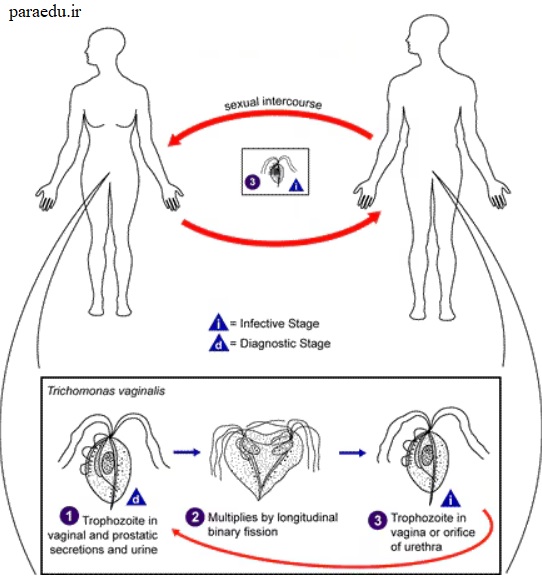سیر تکاملی تریکوموناس واژینالیس نسبتا ساده است. این انگل تک یاخته ای تاژکدار است که دستگاه تناسلی انسان را آلوده می کند و شایع ترین عفونت مقاربتی غیر ویروسی در سراسر جهان است که سالانه میلیون ها نفر را مبتلا می کند. تریکومونیازیس، بیماری ناشی از تریکوموناس واژینالیس، می تواند علائمی مانند ترشحات واژن، خارش، سوزش و درد در زنان و اورتریت، پروستاتیت و اپیدیدیمیت در مردان ایجاد کند. با این حال، بسیاری از افرادی که مبتلا می شوند هیچ علامتی ندارند و می توانند نا آگاهانه عفونت را به دیگران منتقل کنند.
بیماری زایی تریکوموناس واژینالیس:
سیر تکاملی تریکوموناس واژینالیس
چرخه زندگی تریکوموناس واژینالیس نسبتا ساده است و فقط از یک مرحله تشکیل شده است: تروفوزوئیت.
تروفوزوئیت شکل فعال و عفونی انگل است که در دستگاه تناسلی انسان زندگی و تکثیر می شود. این انگل مرحله کیست ندارد، به این معنی که نمی تواند دیواره محافظ تشکیل دهد و در خارج از میزبان زنده بماند. بنابراین، انتقال تریکوموناس واژینالیس عمدتاً از طریق تماس جنسی با فرد آلوده صورت می گیرد.

مورفولوژی سلولی
تروفوزوئیت تریکوموناس واژینالیس گلابی شکل با چهار تاژک قدامی و یک غشای مواج است که به حرکت و اتصال به سلول های میزبان کمک می کند. همچنین دارای یک هسته و یک هیدروژنوزوم بزرگ است که اندامکی است که توسط متابولیسم بی هوازی انرژی تولید می کند. طول تروفوزوئیت حدود ۱۰ تا ۲۰ میکرومتر و عرض آن ۲ تا ۱۴ میکرومتر است.

روش تکثیر
تروفوزوئیت تریکوموناس واژینالیس با تقسیم دوتایی تکثیر می شود، به این معنی که در امتداد محور طولی خود به دو سلول دختر یکسان تقسیم می شود. سرعت تولید مثل انگل به شرایط محیطی مانند pH، دما و در دسترس بودن مواد مغذی بستگی دارد. این انگل می تواند هر ۸ تا ۱۲ ساعت در شرایط بهینه تقسیم شود.
محل جایگزینی
تروفوزوئیت تریکوموناس واژینالیس در مکان های مختلفی در دستگاه تناسلی مردان و زنان قرار دارد. در زنان، انگل عمدتاً دستگاه تناسلی تحتانی مانند واژن، دهانه رحم و مجرای ادرار را آلوده می کند. در مردان، انگل عمدتاً در مجرای ادرار و غده پروستات جایگزین می شود. این انگل گاهی اوقات می تواند سایر نقاط مانند حفره دهان، راست روده و مثانه را نیز آلوده کند.
آنچه در این مقاله مطالعه کردید شامل سیر تکاملی تریکوموناس واژینالیس ، مورفولوژی سلولی، روش تکثیر و محل جایگزینی این انگل در بدن می باشد.
The life cycle of Trichomonas vaginalis
Trichomonas vaginalis is a flagellated protozoan parasite that infects the human genital tract. It is the most common non-viral sexually transmitted infection worldwide, affecting millions of people every year. Trichomoniasis, the disease caused by Trichomonas vaginalis, can cause symptoms such as vaginal discharge, itching, burning, and pain in women, and urethritis, prostatitis, and epididymitis in men. However, many people who are infected do not have any symptoms and can unknowingly transmit the infection to others.
Life cycle
The life cycle of Trichomonas vaginalis is relatively simple and consists of only one stage: the trophozoite. The trophozoite is the active and infective form of the parasite that lives and multiplies in the genital tract of humans. The parasite does not have a cyst stage, which means that it cannot form a protective wall and survive outside the host. Therefore, the transmission of Trichomonas vaginalis occurs mainly through sexual contact with an infected person.
Cell morphology
The trophozoite of Trichomonas vaginalis has a pear-shaped body with four anterior flagella and an undulating membrane that help it move and attach to the host cells. It also has a single nucleus and a large hydrogenosome, which is an organelle that produces energy by anaerobic metabolism. The trophozoite measures about 10 to 20 micrometers in length and 2 to 14 micrometers in width.
The trophozoite of Trichomonas vaginalis reproduces by longitudinal binary fission, which means that it splits into two identical daughter cells along its long axis. The reproduction rate of the parasite depends on the environmental conditions, such as the pH, temperature, and availability of nutrients. The parasite can divide every 8 to 12 hours under optimal conditions.
locations
The trophozoite of Trichomonas vaginalis resides in different locations in the genital tract of men and women. In women, the parasite mainly colonizes the lower genital tract, such as the vagina, cervix, and urethra. In men, the parasite mainly infects the urethra and the prostate gland. The parasite can also occasionally infect other sites, such as the oral cavity, the rectum, and the urinary bladder.
 انگل شناسی پزشکی Medical Parasitology
انگل شناسی پزشکی Medical Parasitology




